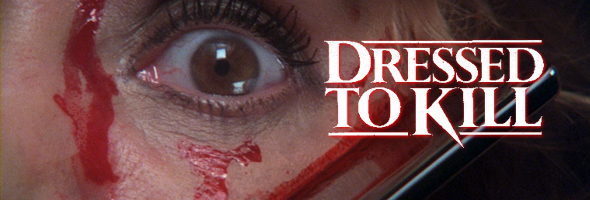
Color, 1980, 105m.
Directed by Brian De Palma
Starring Michael Caine, Angie Dickinson, Nancy Allen, Keith Gordon, Dennis Franz
Kino Lorber (UHD) (US R0 4K), Criterion (Blu-ray & DVD) (US RA/R1 HD/NTSC), Arrow (UHD & Blu-ray) (UK RB HD), MGM (Blu-Ray & DVD) (US RA/R1 HD/NTSC), Carlotta (Blu-Ray & DVD) (France RB/R2 HD/PAL) / WS (2.35:1) (16:9)
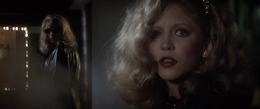
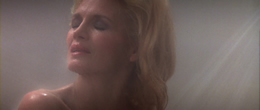 It's difficult to imagine a horror thriller more purely enjoyable than Dressed to Kill, one of the highest peaks of Brian De Palma's career and a gleeful joyride of a film that continues to reward after countless viewings. Though it received a mixed critical response due to De Palma's perceived cribbing from Hitchcock (which didn't affect a huge turnout from the public), the film has gone on to be considered one of the '80s' most accomplished directorial feats in the horror genre and ground zero for the modern erotic thriller, still sitting high above its many successors. Much of the fun here lies in the insidious surprises tucked into both its plot and cinematic language, on the surface a playful riff on Psycho, as well as visual flourishes found in the foreground and background of the frame in every single scene.
It's difficult to imagine a horror thriller more purely enjoyable than Dressed to Kill, one of the highest peaks of Brian De Palma's career and a gleeful joyride of a film that continues to reward after countless viewings. Though it received a mixed critical response due to De Palma's perceived cribbing from Hitchcock (which didn't affect a huge turnout from the public), the film has gone on to be considered one of the '80s' most accomplished directorial feats in the horror genre and ground zero for the modern erotic thriller, still sitting high above its many successors. Much of the fun here lies in the insidious surprises tucked into both its plot and cinematic language, on the surface a playful riff on Psycho, as well as visual flourishes found in the foreground and background of the frame in every single scene.
Angie Dickinson stars as Kate Miller, a New York housewife whose steamy, violent fantasies offer some relief from her unsatisfying sex life with an inattentive husband. While her son, Peter (Christine's Gordon), toils away in his room on science projects, Kate goes to see her analyst, Dr. Elliott (Caine), and spends an afternoon at the museum where she engages in an extended bout of flirting with a handsome stranger. To reveal more would be unthinkable, but other characters gradually work their way into the storyline, including plucky Park Avenue hooker Liz (Blow Out's Allen, Mrs. De Palma at the time) and a mysterious, tall blonde with an unhealthy fondness for straight razors.
After experimenting with a variety of cinematic techniques like split screen, sound layering, and slow motion, De Palma was finally ready to pull out all the stops with this feverish rollercoaster ride. Nary a second is wasted as the viewer is swerved through New York on what amounts to a dark tour of human sexuality, where few people are what they seem and logic is ignored in favor of immediate sensation. At the time the film's combination of erotic visuals and visceral violence was protested by many critics and feminist groups, though the subsequent waves of sexy thrillers have shown just how difficult De Palma's balancing act really was. The sex and violence are essentially tools for a much larger directorial intent to please the viewer at any cost, and even the triple whammy ending (which could have been infuriating in lesser hands) comes off instead as yet another delicious flourish, the icing on an already sinfully rich cake.
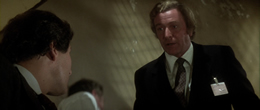 All of the actors seem to be enjoying themselves immensely, particularly during the arch banter between Allen, Gordon, and police detective Dennis Franz, whose laughably huge collars are the only element of the film to suffer with age. Best of all is the sumptuous
All of the actors seem to be enjoying themselves immensely, particularly during the arch banter between Allen, Gordon, and police detective Dennis Franz, whose laughably huge collars are the only element of the film to suffer with age. Best of all is the sumptuous 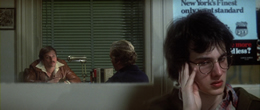 score by Pino Donaggio, one of the finest accomplishments in a criminally underrated career which includes such other De Palma films as Carrie, Blow Out, Body Double, Passion, and Raising Cain. Both men (and Allen and Gordon) had just come off the low budget student film project, Home Movies, and had obviously recharged their batteries for a full throttle exercise that often approaches the operatic.
score by Pino Donaggio, one of the finest accomplishments in a criminally underrated career which includes such other De Palma films as Carrie, Blow Out, Body Double, Passion, and Raising Cain. Both men (and Allen and Gordon) had just come off the low budget student film project, Home Movies, and had obviously recharged their batteries for a full throttle exercise that often approaches the operatic.
Fans of the Donaggio score were served especially well by the 5.1 mix accorded to the film by MGM, first debuted on their DVD marking the midpoint in a strange history on home video. The film was shot in 2.35:1 Panavision and recorded in mono, and in order to garner an R rating, several snippets of nudity and latexy gore were removed from the opening shower fantasy, the infamous elevator scene, and the finale. Also, one line of Allen's dialogue during the erotic speech in Caine's office was redubbed. The uncensored "European" cut of the film surfaced on Warner Home Video in the very early days of VHS, but the brutal panning and scanning destroyed much of the film's effectiveness. Meanwhile Vestron retained laserdisc rights (since this was part of the Filmways library, the reincarnation of American-International Pictures) and released in two versions in the '90s, both R-rated: pan and scan and a later letterboxed edition, sapped of virtually all color, which squeezed the entire frame into a cramped 1.85:1 aspect ratio. The rights then passed to Orion, who issued an "unrated," correctly letterboxed version through Image on laserdisc; though the film was complete in terms of running time, Allen's dialogue was still softened. At the same time the film turned up on VHS again from Goodtimes, in its R-rated form licensed from Orion.
The dissolution of Orion turned the rights over to MGM, and while the R-rated version turned up on DVD first in a letterboxed, optically censored disc from Japan, the American MGM DVD released in 2001 offered the best of both worlds. In a hilarious nod to the inexplicable ratings policies of video stores at the time, the DVD carries a prominent R rating on the back and then discreetly lists "Unrated Version Option" among the special features listing. Using seamless branching, one can either watch the complete Euro cut or the R-rated version. The anamorphic widescreen transfer looks better than previous incarnations, and the rich, striking color design is satisfying; however, there's a fair amount of element damage, which was also present in the film's airings on the MGM HD channel. The audio options include the aforementioned 5.1 mix (nicely recreated from the music and effects tracks and well suited to the film's overheated tone), the original mono mix, and a very funny French track, not to mention French and Spanish subtitles and, amazingly, the film's first presentation with closed captions. The fully loaded special edition contains all the supplements a fan could want (well, except for an isolated score given the wealth of music that still remains unreleased). "The Making of Dressed to Kill" features interviews with De Palma, Dickinson, Allen, Gordon, Franz, and producer George Litto, all of whom offer completely individual 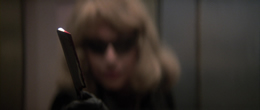 anecdotes about the making of the film. De Palma provides the structuring voice of the piece, though as with his appearance on the Obsession documentary, it's apparent he feels more comfortable behind a camera than in front of one. Interestingly, little attention is given to the radical transformation the film underwent during its various drafts, beginning as a vignette in a proposed De Palma film of Cruising to the finished form today. Check out the discontinued but easily available paperback novelization for a peek at an earlier, fascinating draft of the story, including a completely different opening. Allen seems to have the best memory for the production, though everyone offers something of value. And don't miss Dickinson's surprise use of one of the film's props during the end credits. Two featurettes cover the censorship aspects of the film, one comparing the variant unrated, R, and bastardized TV cuts, and the other ("Slashing Dressed to Kill") recounting the protests and violent reactions during its release as well as the MPAA scandal, one of the first of many. "An Appreciation by Keith Gordon" features the actor/director recounting his own experiences with the film and, as with his appearance on the Jaws 2 disc, explaining how it influenced his later career choice. Other extras include the spoiler-packed theatrical trailer, two galleries of promotional photographs and the terrific advertising art both used and rejected, and the usual "collectible booklet," which appears to have been hastily prepared and incorrectly lists Body Double as De Palma's next film.
anecdotes about the making of the film. De Palma provides the structuring voice of the piece, though as with his appearance on the Obsession documentary, it's apparent he feels more comfortable behind a camera than in front of one. Interestingly, little attention is given to the radical transformation the film underwent during its various drafts, beginning as a vignette in a proposed De Palma film of Cruising to the finished form today. Check out the discontinued but easily available paperback novelization for a peek at an earlier, fascinating draft of the story, including a completely different opening. Allen seems to have the best memory for the production, though everyone offers something of value. And don't miss Dickinson's surprise use of one of the film's props during the end credits. Two featurettes cover the censorship aspects of the film, one comparing the variant unrated, R, and bastardized TV cuts, and the other ("Slashing Dressed to Kill") recounting the protests and violent reactions during its release as well as the MPAA scandal, one of the first of many. "An Appreciation by Keith Gordon" features the actor/director recounting his own experiences with the film and, as with his appearance on the Jaws 2 disc, explaining how it influenced his later career choice. Other extras include the spoiler-packed theatrical trailer, two galleries of promotional photographs and the terrific advertising art both used and rejected, and the usual "collectible booklet," which appears to have been hastily prepared and incorrectly lists Body Double as De Palma's next film.
Ten years later, MGM revisited the title as a Blu-Ray complete with a very spare menu and the extras ported over. Only the unrated version is included, which is fine but a little unfortunate since the two razor attacks arguably play slightly better for first time viewers thanks to the omission of two very unconvincing latex close ups. Some additional damage repair was done, with the prevalent speckles over the opening credits and shower scene finally removed. The original mono audio track is ditched with only a DTS-HD 5.1 mix included (along with the same French dub, an odd call. A year later in 2012, Carlotta Films in France released an alternate Blu-Ray special edition containing a similar transfer and a quartet of different featurettes produced by Fiction Factory. 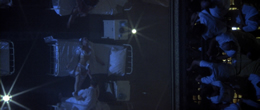
Those European extras were combined with all of the American ones for the 2013 Arrow Blu-ray (with no DVD counterpart), which results in a solid companion piece to their excellent De Palma releases of Obsession and Blow Out. The main U.S. doc (retitled "The Making of a Thriller") and the comparison and censorship bits are here along with the trailer and gallery, plus the four very substantial additional solo interviews. In "Symphony of Fear," Litto spends 17 minutes explaining the process of bringing the film from script to screen, De Palma's creative requirements, working with the budgetary limitations of what was AIP at the time, and dealing with the MPAA. Dickinson, still a prime candidate for the coolest actress on the planet, gets to dissect her role in great detail in the 29-minute "Symphony in White," in which she talks fondly about the film as her finest acting job, shares more memories of the body double process for the shower scene, and provides some highly memorable sound bites like "We're doing beaver shots here!" and "I almost never wanted to get in a taxi again." Then the articulate and charming Allen gets her turn for 23 minutes with "Symphony in Purple," in which she reiterates some of her thoughts on De Palma's technique, her big break on Carrie, her dancing skills influencing her sense of movement in front of the camera, reuniting with Gordon, and the challenges of shooting her one pivotal scene with Michael Caine. Finally Gordon, who became a director of feature films as well as TV shows like Dexter and The Killing, gets a 30-minute spotlight in "Lessons in Filmmaking," in which he talks about being cast for a character originally written for a much younger actor, his frustration with critical misreading of the film's most audacious narrative shock, and how the production process helped him learn the skills necessary to make the move behind the camera later in his career. The transfer itself looks very close to the previous ones, though in a nice touch, the original mono track is included as well along with optional English subtitles. The liner notes booklet contains a perceptive essay by writer Maitland McDonagh, who ties it to the Italian giallo craze (with Dario Argento's Tenebrae offering its own '80s commentary complete with straight razor two years later) and discusses its impact as a study of "throwaway women." Also essential is a text interview by Daniel Bird with director and graphic designer Stephen Sayadian, aka Rinse Dream (director of the incredible Cafe Flesh), whose company was behind the iconic one-sheet poster for Dressed to Kill (and which was recreated in his film Nightdreams one year later).
Two years later, De Palma's classic got another round on both American Blu-ray and DVD courtesy of The Criterion Collection, presenting a combination of new and preexisting extras. Touted as a new 4K transfer supervised by De Palma, the first batch of review discs featured a problematic transfer that goes haywire after the first reel; however, corrected versions are said to be on the way with a delayed street date that should prevent the erroneous pressing from reaching consumers. What's definitely true here is that this features the restoration of the original scope Filmways logo (finally!) after the MGM one and looks significantly more detailed than before, with potent albeit somewhat more golden colors compared to the past MGM version. It also sports more picture information on the left side, in fact quite a bit more in many shots. The LPCM mono audio is true to the original theatrical mix and sounds excellent, while optional English subtitles are provided. Should anyone accidentally stumble on a bad copy, Criterion has implemented a disc replacement program.
There's bound to be far less controversy about the value of the new slate of interviews, which are exceptional overall and nearly justify a double dip by themselves. The new De Palma interview "A Lost Art" (19 mins.) features him conversing with filmmaker Noah Baumbach about the genesis of the story, the importance of blocking scenes for a large scene, the state of his career at the time, and that inevitable topic, the Hitchcock influence. De Palma's in fine form here as always, and Baumbach generally lets him do his thing. In "Characterization and Choreography," the still-gorgeous and always articulate Nancy Allen gives a 16-minute walkthrough about the weight of taking of her first major leading role, working with the generous Caine under unorthodox conditions, and collaborating with Klute costume designer Ann Roth on the textured garb for her character, including that memorable purple dress. Covering much of the same ground as the old Litto interview is the 12-minute "More Than Money," an updated chat with the producer who also offers a bit more info about how he first wound up with De Palma getting Sisters distributed through AIP and what it was like working on their multiple projects together (also including Obsession and Blow Out). The new Donaggio interview, "The Music Is an Actor," features the great composer discussing his De Palma collaboration for 15 minutes including his approach to do a "Picasso" on the structure of film music and his decision to add breathy voices at key moments for an intense emotional effect. He also reveals that he and De Palma have different favorites among their work together, but you'll have to watch to find out what they are. Things get really interesting with a new interview with Victoria Lynn Johnson, whose 8-minute "Body Double" interview charts her path from a young model through ad campaign fixture to her famous appearance as Dickinson's uncredited body double. It's a very funny, candid look at her iconic participation in the film, including a great bit about having to do some intimate hair dying and some amusing looks at how she's turned up in pop culture since then including Trivial Pursuit. Finally Sayadian gets to appear on camera this time for the 10-minute "The Art of the Sell," which covers his origins creating striking cover art and sex toy ads for Hustler through the ad campaigns on films including The Awakening, Take This Job and Shove It, and adult VHS covers that often bore no relationship to (and frequently surpassed) the actual features. He also tells the story behind the striking image seen on the paperback tie-in, which is just as effective as the main key art chosen for the poster, and explains the lengthy homage to the poster art in Nightdreams, which leads to a great punchline at the end. Why someone hasn't done Blu-ray special editions of his two 35mm adult classics (as well as the more legit Dr. Caligari) is a mystery for the ages.
Carried over from the prior releases are the making-of and censorship featurettes, the Keith Gordon appreciation, the unrated and R-rated comparison, and the theatrical trailer, but there are still a few more new goodies tucked in as well. In "Defying Categories," director Michael Apted and video artist Peer Bode discuss the film's late cinematographer, Ralf Bode, for 10 minutes, with the former recalling his work on the same year's Coal Miner's Daughter and both covering his extreme versatility and background as an actor. A selection of storyboards also shows a sample of how De Palma charted out the entire film on paper, focusing on the original (unfilmed) prologue depicting a character's castration in impressionistic detail as well as the split-screen Caine and Allen phone sequence. The package also comes with a fold-out liner notes essay by Michael Koresky focusing on the film's multitude of doubling symbolism. No matter which version you get, what remains inside is a dazzling thriller for the mind and the senses as well as a perfect encapsulation of De Palma's enduring appeal as a cinematic artist.
Updated review on August 10, 2015.



 It's difficult to imagine a horror thriller more purely enjoyable than Dressed to Kill, one of the highest peaks of Brian De Palma's career and a gleeful joyride of a film that continues to reward after countless viewings. Though it received a mixed critical response due to De Palma's perceived cribbing from Hitchcock (which didn't affect a huge turnout from the public), the film has gone on to be considered one of the '80s' most accomplished directorial feats in the horror genre and ground zero for the modern erotic thriller, still sitting high above its many successors. Much of the fun here lies in the insidious surprises tucked into both its plot and cinematic language, on the surface a playful riff on Psycho, as well as visual flourishes found in the foreground and background of the frame in every single scene.
It's difficult to imagine a horror thriller more purely enjoyable than Dressed to Kill, one of the highest peaks of Brian De Palma's career and a gleeful joyride of a film that continues to reward after countless viewings. Though it received a mixed critical response due to De Palma's perceived cribbing from Hitchcock (which didn't affect a huge turnout from the public), the film has gone on to be considered one of the '80s' most accomplished directorial feats in the horror genre and ground zero for the modern erotic thriller, still sitting high above its many successors. Much of the fun here lies in the insidious surprises tucked into both its plot and cinematic language, on the surface a playful riff on Psycho, as well as visual flourishes found in the foreground and background of the frame in every single scene.  All of the actors seem to be enjoying themselves immensely, particularly during the arch banter between Allen, Gordon, and police detective Dennis Franz, whose laughably huge collars are the only element of the film to suffer with age. Best of all is the sumptuous
All of the actors seem to be enjoying themselves immensely, particularly during the arch banter between Allen, Gordon, and police detective Dennis Franz, whose laughably huge collars are the only element of the film to suffer with age. Best of all is the sumptuous  score by Pino Donaggio, one of the finest accomplishments in a criminally underrated career which includes such other De Palma films as Carrie, Blow Out, Body Double, Passion, and Raising Cain. Both men (and Allen and Gordon) had just come off the low budget student film project, Home Movies, and had obviously recharged their batteries for a full throttle exercise that often approaches the operatic.
score by Pino Donaggio, one of the finest accomplishments in a criminally underrated career which includes such other De Palma films as Carrie, Blow Out, Body Double, Passion, and Raising Cain. Both men (and Allen and Gordon) had just come off the low budget student film project, Home Movies, and had obviously recharged their batteries for a full throttle exercise that often approaches the operatic.  anecdotes about the making of the film. De Palma provides the structuring voice of the piece, though as with his appearance on the Obsession documentary, it's apparent he feels more comfortable behind a camera than in front of one. Interestingly, little attention is given to the radical transformation the film underwent during its various drafts, beginning as a vignette in a proposed De Palma film of Cruising to the finished form today. Check out the discontinued but easily available paperback novelization for a peek at an earlier, fascinating draft of the story, including a completely different opening. Allen seems to have the best memory for the production, though everyone offers something of value. And don't miss Dickinson's surprise use of one of the film's props during the end credits. Two featurettes cover the censorship aspects of the film, one comparing the variant unrated, R, and bastardized TV cuts, and the other ("Slashing Dressed to Kill") recounting the protests and violent reactions during its release as well as the MPAA scandal, one of the first of many. "An Appreciation by Keith Gordon" features the actor/director recounting his own experiences with the film and, as with his appearance on the Jaws 2 disc, explaining how it influenced his later career choice. Other extras include the spoiler-packed theatrical trailer, two galleries of promotional photographs and the terrific advertising art both used and rejected, and the usual "collectible booklet," which appears to have been hastily prepared and incorrectly lists Body Double as De Palma's next film.
anecdotes about the making of the film. De Palma provides the structuring voice of the piece, though as with his appearance on the Obsession documentary, it's apparent he feels more comfortable behind a camera than in front of one. Interestingly, little attention is given to the radical transformation the film underwent during its various drafts, beginning as a vignette in a proposed De Palma film of Cruising to the finished form today. Check out the discontinued but easily available paperback novelization for a peek at an earlier, fascinating draft of the story, including a completely different opening. Allen seems to have the best memory for the production, though everyone offers something of value. And don't miss Dickinson's surprise use of one of the film's props during the end credits. Two featurettes cover the censorship aspects of the film, one comparing the variant unrated, R, and bastardized TV cuts, and the other ("Slashing Dressed to Kill") recounting the protests and violent reactions during its release as well as the MPAA scandal, one of the first of many. "An Appreciation by Keith Gordon" features the actor/director recounting his own experiences with the film and, as with his appearance on the Jaws 2 disc, explaining how it influenced his later career choice. Other extras include the spoiler-packed theatrical trailer, two galleries of promotional photographs and the terrific advertising art both used and rejected, and the usual "collectible booklet," which appears to have been hastily prepared and incorrectly lists Body Double as De Palma's next film. 